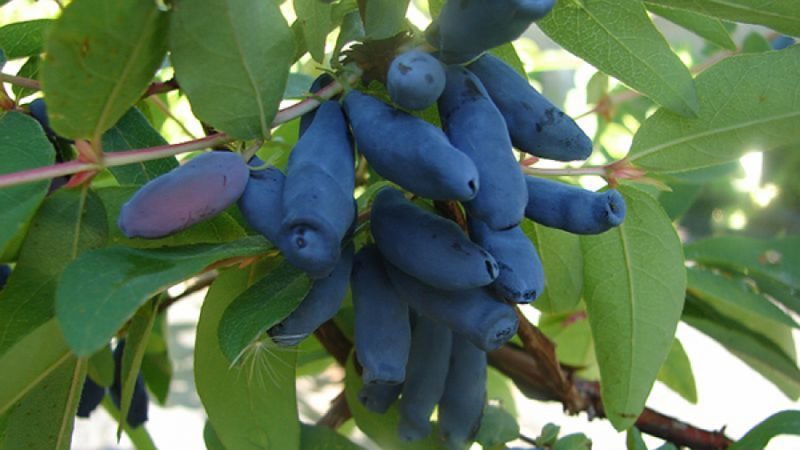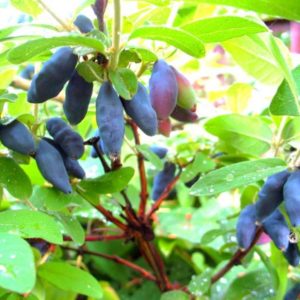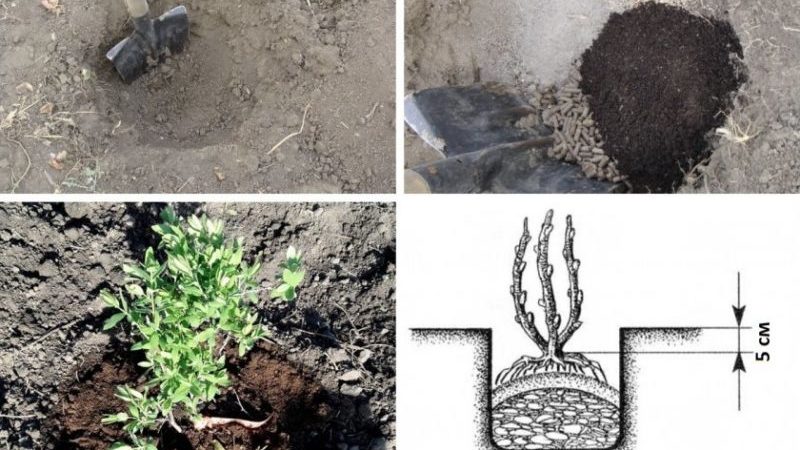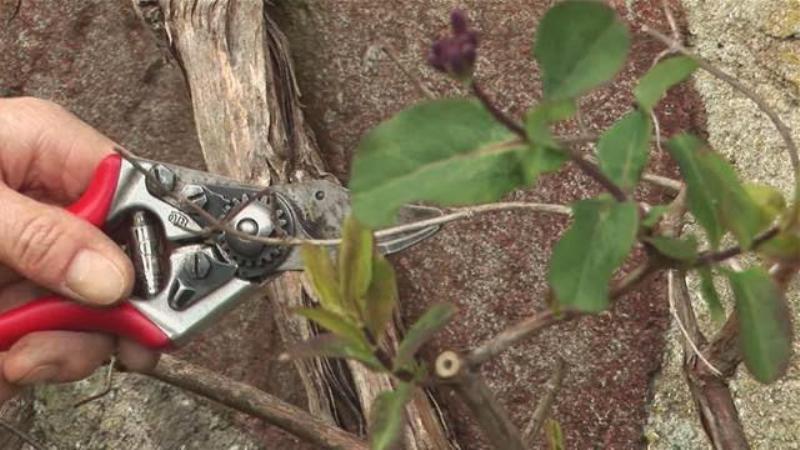High-yielding, frost-resistant honeysuckle variety Tomichka
The Tomichka variety enjoys stable popularity among honeysuckle lovers. Its success is due to the pleasant taste and rich chemical composition of the berries, ease of maintenance, frost resistance and decorative qualities of the bushes. This article details the features varieties and the nuances of growing it.
The content of the article
Description of the variety of honeysuckle
Honeysuckle Tomichka is the result of the work of domestic breeders. Its fruits are characterized by an unusual shape and pleasant sweet taste with a slight sourness. They contain 30 kcal per 100 g, up to 24 mg of ascorbic acid and about 770 mg of P-active substances.
Origin and development, history of breeding
This is a variety of Siberian honeysuckle, bred as a result of free pollination of the elite form of honeysuckle Turchaninov No. 68/2 at the Bakcharsky support point of the N.I. M.A.Lisavenko. Project leaders - IK Gidzyuk and ZI Luchnik.
The variety has been on state testing since 1984, it was entered into the State Register of Russia in 1987.
Characteristics, description of appearance, taste

The bushes are medium-sized, grow up to 1.8 m in height, rounded, dense and spreading. Shoots are green, thin and curved... Leaves are medium in size, oval with an elongated sharp tip, green or light green, slightly pubescent. The flowers are small, pale green.
The berries are drop-shaped or cylindrical in shape, large, weigh an average of 1 g and reach 2.5 cm in length. The peel is thin, bumpy, covered with a waxy bloom; during ripening it becomes deep purple, almost black. The pulp is soft and juicy. The taste is sweet with sourness.
Application features
Tomichka fruits are consumed fresh, dried, frozen, used for making preserves, jams, compotes and other types of preservation. Made from berries and food colors, which are used in the manufacture of wines (for example, the Georgian "Kakheti").
Also, the bushes of this variety of honeysuckle have an attractive appearance and are used for decorative purposes.
Ripening period, yield and fruiting
This is an early ripening variety, the berries ripen in early June.
The bushes begin to bear fruit 4 years after planting. Average yield - 53 c / ha, maximum - 110 c / ha.
Disease and pest resistance
The variety is characterized by resistance to diseases and pests. However, as a result of its proximity to other varieties of honeysuckle and various fruit and berry crops, it can be affected by:
- honeysuckle aphid;
- shield;
- mite;
- leaf roll;
- miner;
- mol-persian;
- sawfly;
- honeysuckle bug;
- finger wing;
- fungal and viral diseases.
Cold and drought resistant
The variety is frost resistant. Shoots can withstand temperatures as low as -50 ° C, roots down to -40 ° C, flower buds, ovaries and buds do not fall off at -8 ° C.
The bushes do not tolerate drought well, due to a lack of moisture, yield decreases.
For which regions it is best suited and what is the exacting climate
Initially, the variety was included in the State Register for the West Siberian and Northwestern regions, but due to its unpretentiousness to climatic conditions, it successfully grow in all areas.
The main advantages and disadvantages of the variety
Pros of Tomichka:
- frost resistance;

- resistant immunity to diseases and pests;
- the possibility of universal use of berries;
- relatively good transportability;
- decorativeness of shrubs;
- unpretentious care;
- no need for frequent transplants;
- stable fruiting for 30 years.
Disadvantages of the variety:
- poor resistance to drought;
- the need for pollinators;
- shedding berries after ripening.
What is the difference from other varieties and hybrids
Comparison of Tomichka with other early varieties:
| Variety | Ripening period | Average weight of berries, g | Taste | Berry shape | Productivity, c / ha |
| Tomichka | Early | 1 | Sweet with sourness | Teardrop or cylindrical | 53 |
| Enchantress | Early | 1-1,3 | Sweet and sour | Pear-shaped or elliptical | 40,6 |
| Fortune | Early | 0,8 | Sweet and sour | Elliptical | 63,7 |
| Three friends | Early | 1,4 | Sweet and sour | Elongated oval | 83 |
Agrotechnics
In order for the bushes to develop well and bear fruit, it is important to choose the right seedlings and the place of their planting, as well as to provide the plants with competent care.
Choosing a place in the garden and preparing holes
The honeysuckle planting site should be well lit and protected from drafts and gusty winds.
This is a moisture-loving culture, but stagnant water at the roots leads to their decay. Make sure that the groundwater level is no higher than 1 m from the surface of the earth.
Reference. Tomichka develops well in partial shade, but in this case it reduces the yield and quality of berries.
Preparing for landing
Suitable for planting are 2-year-old seedlings 40 cm in height with at least 2 strong shoots and healthy branched roots. Before planting on the site, they are soaked in a solution of growth stimulants ("Epin", "Kornevin").
The soil is pre-cleaned of plant residues and dug up.
Ground requirements
Tomichka prefers loose, fertile soil with good moisture and air permeability and neutral acidity. The best option is loam and sandstone.
Timing, scheme and landing rules

In honeysuckle, the growing process ends early, so the plants are planted from late August to the second half of November. Spring planting of seedlings is acceptable, but in this case it is necessary to be in time before the start of the growing season.
Important! When planted in spring, seedlings take root worse.
Landing rules:
- Dig planting holes in the area of 50 × 50 cm at a distance of at least 1.5 m from each other.
- Half fill them with a nutrient mixture (a bucket of humus or compost, half of the dug earth, 100 g each of potassium salt and double superphosphate, 1 tbsp. Wood ash) and pour water.
- In the center of the pits, place seedlings vertically, spread their roots.
- Cover the plants with soil mixture, tamp and water.
- When the soil subsides, add more nutrient mixture so that the root collar is deepened by a maximum of 4 cm.
- Make near-trunk ditches, water abundantly.
- Cover the ground with humus, straw or sawdust.
Features of growing and nuances of care
When watering, they are guided by the condition of the soil: it must be wet, but stagnation of water is unacceptable. On average, the bushes are watered 2-3 times a month, pouring 10-15 liters of water under each.
After each watering and rain, the soil is loosened to avoid the formation of a dry crust on its surface and to improve the access of water and oxygen to the roots. Simultaneously with loosening, weeding is carried out, removing weeds, which takes nutrients from the soil, creates a favorable environment for the development of diseases and attracts pests.
After 3 years after planting, the plants begin to feed.In early spring, organic and nitrogen-containing fertilizers are applied (manure, compost, ammonium nitrate, urea), in September, 100 g of wood ash are poured under each bush.
Important! This variety does not like mineral fertilizing.
In the first 5 years after planting, only sanitary pruning is carried out, removing dry, damaged shoots and excess root growth. The remaining branches are pinched to a third of the length.

Bushes over 6 years old require rejuvenating pruning, in which old branches are cut at ground level, leaving hemp 30-40 cm long. After the procedure, a maximum of 10 strong shoots and young growth remain on the bush.
The bushes are pruned at the end of October, after the procedure, they are treated with Bordeaux liquid.
Pollinators
Tomichka is a self-fertile, cross-pollinated variety. The most suitable pollinators are seedlings and selected forms of Turchaninov's and Kamchatskaya's honeysuckle, as well as varieties Goluboe Spindle, Kamchadalka, Blue Bird, Pavlovskaya, Cinderella, Bakcharskaya, In Memory of Gidzyuk, Vasyugan.
Disease and pest control
Diseases and pests that can infect Tomichka:
| Disease / pest | Symptoms | Treatment |
| Honeysuckle aphid | Yellowing, deformation and leaf fall | Biotlin treatment |
| Shield | Spraying "Aktellikom", "Rogor" | |
| Mite | Processing "Sunmight", "Apollo", "Oberon" | |
| Leaf roll | Holes appear in the leaf plates, the leaves roll into a tube | Treatment of bushes with insecticides, for example "Iskra", "Inta-Virom" |
| Miner | ||
| Moth persian | ||
| Sawfly | ||
| Honeysuckle bug | ||
| Fingerwing | The fruits wrinkle and fall off | Spraying with "Prestige", "Respect", "Fitoverm" or "Aktara" |
| Fungal diseases (cercosporiasis, powdery mildew, tuberculariosis, ramulariasis) | Various spots appear on leaves and shoots | Processing by "Previkur", "Energy", "Bravo", "Acrobat", "Tattu", "Quadris" |
| Viral diseases (mosaic virus of razuha, mottling of leaves, frost cracks of shoots) | Foliage is painted with variegated flowers | The bushes are dug up together with the roots and burned |
Preparing for winter
Late autumn the bushes are cut off, plant residues and a layer of old mulch are removed from the ground around them and burned, the soil is loosened, a new root circle is made, watered and mulched again with humus, peat, sawdust or straw.
To prevent diseases and pests, the bushes and the ground under them are sprayed with fungicides (Gamair, Quadris, Maxim) and insecticides (Aktellik, Aktara).
Reproduction
Most often, Tomichka is propagated by vegetative methods: cuttings, dividing the bush, layering.
For cuttings, green and semi-lignified shoots are used. The cuttings are placed in a container with nutrient soil, pretreated with growth stimulants ("Kornevin", "Heteroauxin"), and covered with polyethylene. Plants are regularly watered and ventilated. With proper care, young seedlings are obtained by the end of the season.
Reference. This is the most difficult method, while the survival rate is low in comparison with other breeding methods.
At the end of the growing season, propagation is carried out by layering. To do this, choose a strong shoot located below, bend it to the ground, fix it and add it in. After about a year, a root system is formed. After that, the shoot is separated from the mother bush and planted in a permanent place.
The division of the bush is carried out in early spring, before the beginning of the growing season. In this case, there is no need to completely dig out the bush. For reproduction, several developed shoots are chosen, they are dug in, taken out with the root and planted in a new place.
Harvesting
The harvest ripens in early June. Full maturity occurs 5-7 days after the berries turn blue. It is important to have time to remove them from the bushes before this moment, otherwise they will fall off.
Harvest by hand or by shaking the berries from the bushes into the tissue underneath. Fruits are kept fresh in the refrigerator for up to 7 days and frozen for 3-4 years.
Reference. Due to the uneven ripening of the berries, the harvest is carried out several times.
What can be the difficulties in growing
Problems when growing Tomichka's honeysuckle:
- the bushes stop developing, wither and disappear - probably rotting of the roots occurs due to excessive watering or stagnant moisture;
- the plants develop slowly, the yield is low - the bushes grow in the shade;
- shoots and leaves wither - a sign of pests.
Tips and reviews of experienced gardeners about the variety
Gardeners' recommendations:
- plant honeysuckle in late summer or autumn, in spring the bushes do not take root well;
- do not plant Tomichka after gooseberries, other varieties of honeysuckle or currants, these plants are better suited as neighbors, not predecessors.
There are both positive and negative reviews of farmers about the Tomichka variety:
Marina, Tomsk: “I have been growing Tomichka for a long time, I am very pleased with this variety. I like the fact that the shrubs bear fruit steadily, and even beautiful in themselves. The berries are tasty, sweet with a slight sourness and useful... Bushes rarely get sick, they grow quickly. I do not see any flaws in the grade for myself. "
Victoria, Novosibirsk: “I tried to grow Tomichka several times and failed each time. Young seedlings do not tolerate winter well, even with good cover they froze. And the cuttings do not take root at all, most of them died. The berries, of course, are tasty, but they crumble and ripen not at the same time. For me personally there are much more minuses than pluses ".
Conclusion
Tomichka's honeysuckle, despite the presence of some shortcomings, was liked by most gardeners. This variety does not have any special requirements for care, it bears fruit stably, is frost-resistant and gives a rich harvest of tasty and healthy berries.